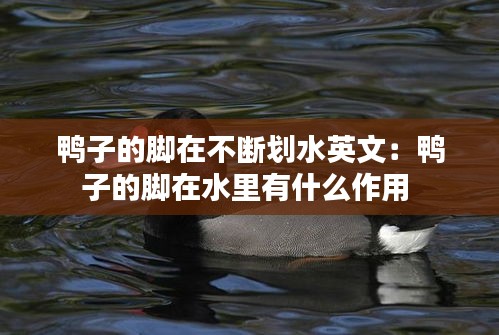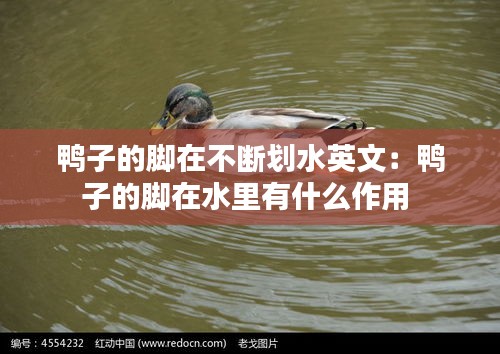The Constant Sculling of a Duck's Feet
The world of waterfowl is one that is often overlooked, yet it is filled with fascinating behaviors and movements. One such behavior that stands out is the constant sculling of a duck's feet. This seemingly simple action is, in fact, a crucial part of a duck's life, enabling them to navigate through their aquatic environment with ease.
The Anatomy of a Duck's Foot
To understand the sculling motion of a duck's feet, it is important to first look at the anatomy of a duck's foot. Unlike human feet, which are designed for walking and running on land, a duck's foot is a specialized adaptation for life in the water. It is webbed, with the toes pointing forward, allowing the duck to effectively propel itself through the water.
The webbing between the toes is made up of a tough, elastic membrane that helps to create a paddle-like shape when the duck's feet are submerged. This membrane is reinforced by a series of bones that provide structural support and allow the foot to move with flexibility and precision.
The Sculling Motion
The sculling motion of a duck's feet is a complex series of movements that work together to propel the duck through the water. When a duck is swimming, it uses its feet in a rhythmic, paddling motion. The legs are extended and the feet are pushed back and forth, creating a series of strokes that move the duck forward.
As the duck's feet move, the webbing between the toes creates a wake in the water. This wake is a series of ripples that help to propel the duck forward. The duck's body is designed to be streamlined, minimizing drag and allowing the sculling motion to be as efficient as possible.
The Importance of Sculling
The sculling motion is not just a way for ducks to move through the water; it is also a crucial part of their survival. Ducks are prey animals, and their ability to swim quickly and efficiently is a key factor in avoiding predators. By using their feet to scull, ducks can escape from danger and find safe refuge in the water.
Additionally, sculling is essential for a duck's daily activities. Whether it is foraging for food, courtship displays, or simply basking in the sun, ducks rely on their ability to navigate the water effectively. The sculling motion allows them to move with grace and agility, making them one of the most adaptable birds in the animal kingdom.
The Evolution of Sculling
The sculling motion in ducks is the result of millions of years of evolution. Over time, ducks have developed specialized feet and leg structures that are perfectly adapted to life in the water. This adaptation is not unique to ducks; many other waterfowl, such as geese and swans, also use sculling to move through the water.
The evolution of sculling can be traced back to the common ancestor of all waterfowl. This ancestor likely had feet that were adapted for wading in shallow water, but over time, these feet evolved into the specialized webbed feet we see today. This adaptation allowed the ancestor to move more efficiently in the water, which in turn led to increased survival rates and the spread of the species.
The Science Behind Sculling
The sculling motion of a duck's feet is not just a matter of physical anatomy; it is also a complex scientific process. When a duck sculls, it is effectively creating a forward momentum by pushing against the water. This process is governed by the laws of physics, specifically Newton's third law of motion, which states that for every action, there is an equal and opposite reaction.
As the duck's feet push against the water, the water pushes back with equal force, propelling the duck forward. The efficiency of this process is influenced by a variety of factors, including the duck's body shape, the angle of the feet, and the speed of the stroke. By understanding these factors, scientists can gain insights into the evolutionary advantages of the sculling motion.
The Impact of Sculling on Duck Behavior
The sculling motion has a significant impact on the behavior of ducks. It allows them to engage in a wide range of activities, from foraging for food to socializing with other ducks. The ability to scull also enables ducks to migrate long distances, as they can maintain their momentum over long periods of time.
Moreover, the sculling motion is an integral part of the courtship rituals of many duck species. Male ducks often perform elaborate displays of sculling as part of their mating rituals, showcasing their strength and agility to potential mates. This behavior is not only a testament to the importance of sculling in a duck
转载请注明来自浙江远邦实业集团有限公司,本文标题:《鸭子的脚在不断划水英文:鸭子的脚在水里有什么作用 》















 蜀ICP备2022005971号-1
蜀ICP备2022005971号-1
还没有评论,来说两句吧...